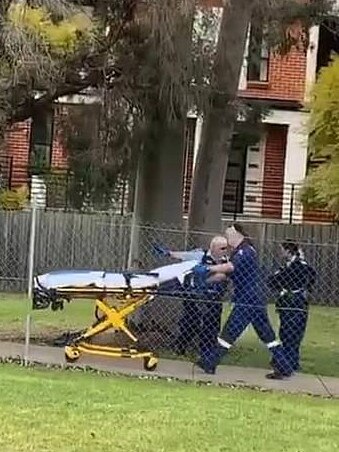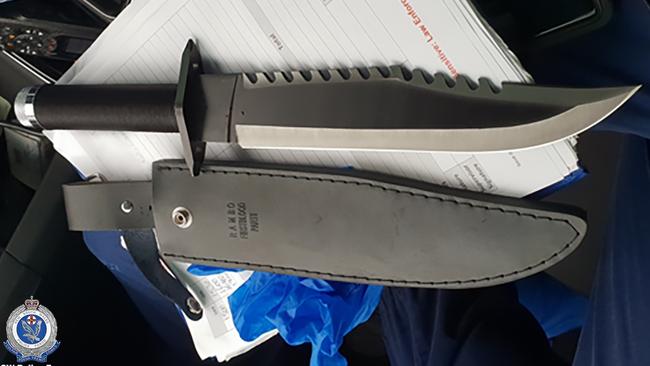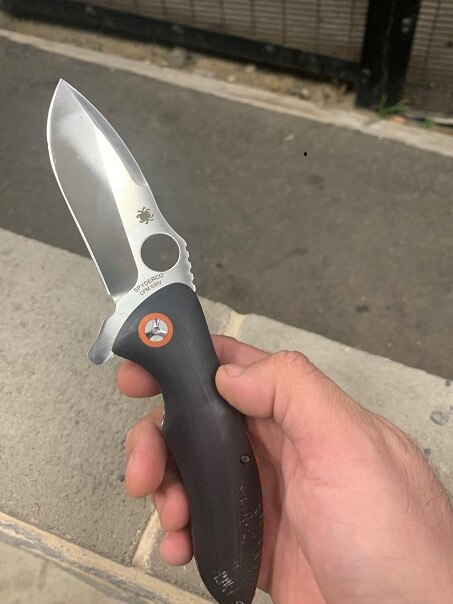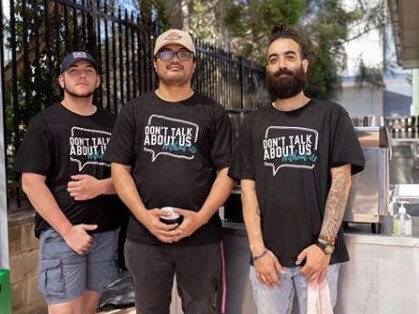Sydney teens on a knife edge as fear drives culture of ‘carrying’
Children as young as 12 are carrying knives for protection on Sydney’s streets, with fears as many as one in three teens are arming themselves for safety — and status.
Police & Courts
Don't miss out on the headlines from Police & Courts. Followed categories will be added to My News.
BOYS as young as 12 are carrying knives for protection and status on the streets, as fears grow that the culture of “carrying” is being normalised among teenagers.
Youth workers warn COVID-19 is exacerbating the problem — as unemployment and financial stresses ramp up at home, more young people become disengaged and disadvantaged.
Blacktown Youth Services Association manager Natalie Chiappazzo estimated one in three young people were carrying a knife and they were getting younger.
“Five or six years ago, when there was beef between them, they would be using their hands. Now everyone’s carrying a knife … they’re willing to pull it out whenever,” she said.
“It’s the fear — they know people are carrying, they think: ‘Oh, I better carry just in case’.”

Blacktown Youth Services Association (BYSA) has been on the frontline with at-risk youth for 32 years, working with the community’s most disadvantaged 12-24 year olds in an area with some of the state’s highest rates of juvenile offenders, domestic violence and child protection issues.
Ms Chiappazzo said late last year, kids at the service began raising the alarm about the number of knives on the streets, fearing someone would get killed if nothing changed.
“We sent emails out to our stakeholders but were told it wasn’t an issue in our area, which is the complete opposite to what our young people were saying,” she said.

In June, after a disturbing confrontation between teenage boys armed with a machete, knives and hammers at Rooty Hill station in front of shocked commuters, police intensified efforts to get knives off the streets.
The brawl involved members of the warring OneFour/Greater West and Inner West gangs and led to multiple arrests, with a magistrate remarking it was lucky no-one was killed.
Police documents tendered in court said the incident was one of a rising number of gang altercations across Western Sydney, sparked by the stabbing death of a 20-year-old Inner West gang associate at Parramatta train station in late 2018.
While overall levels of knife violence in NSW have remained steady, the number of knife-related offences involving young people is troubling.
Almost 30 per cent of violent incidents involving knives or blades between June 2019 and June 2020 involved people under 19, the majority of them assaults and robberies.


Knives are also not just a Western Sydney issue. A string of bloody stabbings involving teenagers occurred right across Sydney between June and September, among them the alleged vicious attack on an innocent father in Pyrmont by nine teenagers — several from elite Sydney schools — a triple stabbing at a footy match in North Parramatta and the alleged stabbing of an off-duty female cop in Newtown.
BYSA youth leader Nickolas Koutsoudakis said kids carrying knives was not new but social media meant they were now far more open about it.
“It used to be more of a closed culture, a hooligan culture,” he said. “Now people are much more expressive.
“If you want to be noticed, you have to show that little bit of ego; if people think you’re tougher then that’s when you get noticed, and I think that’s the vicious cycle of behaviour.”
Lui Savea, another youth leader at BYSA agreed, saying back in his day, kids would never brag about carrying: “Now you’ve got young people out there saying: ‘I’m big, I’m big, touch me, I’ll stab you’. Then when it happens they go through this really traumatic process.”

Jay 16*, a regular at BYSA, said kids were spruiking their weapons on social media and he had seen 11 and 12-year-olds carrying knives over “stupid sh*t” with other teens.
He has seen a kid stabbed and used to carry a knife in case he got “pulled up” by other boys.
“I know people who carry knives,” he said. “They think it’s cool, they class it as protection, like: ‘Oh, I need this just in case so-so comes around, I’m prepared’.
“It is a problem, 100 per cent, but you never know until someone actually tells you it is … the police wouldn’t know how much it is, you’d be surprised.”
Since coming to BYSA and turning his focus to music, Jay is no longer part of that world.
“They way I think of it, if I were to be carrying a knife and use it, I don’t want that kid’s mum crying at their funeral,” he said.
“I don’t want my family crying around me in a hospital bed or a casket. I don’t need to carry around a weapon to feel safe.”
Between January and September, police seized 425 knives and other prohibited weapons on and around the city’s transport network — that’s an average of about 47 a month.
But in June, after the Rooty Hill incident, police increased efforts targeting knife crime and weapons, said Police Transport Command Northwest Acting Superintendent Naomi Moore.
“Young men carrying knives is a real issue in Sydney,” said Acting Supt Moore.
“We’ve been very, very focused on what we identified as something that had progressed to the point that we needed to throw a lot more at this problem.”

Young men aged between 15-19 were mainly carrying weapons to protect themselves, she said, although there were others “willing to use it and threaten people”.
It also isn’t just knives — other objects modified to harm including bottles and poles have been seized, and hammers seem to be “a real weapon of choice” as they’re easily accessible.
“A lot of it is about having themselves armed and ready if someone does confront them,” she said.
“I think there is loosely some gang activity and some baiting each other on social media and other platforms … I think that tends to escalate the behaviour.”
The concern is teenage boys don’t have the maturity to draw a line between threatening someone and potentially or accidentally using a knife.
“That’s what were trying to prevent, we want to get them off the streets and out of their hands so they don’t have to make that decision,” she said.


Most kids carrying weapons are worried about people “jumping” them or groups of kids attacking them, said Lui Savea, and mainly carry when there’s conflict.
“But the ones who feel like they need to carry it every single day are the ones who’ve experienced really bad trauma over the years,” he said.
A few months ago, he saw two 16-year-old boys pull knives on each other at Blacktown over an altercation at a party. They were about to start swinging when Lui intervened.
“It wasn’t planned, it was enough for the two of them to just see each other for both of them to pull out a knife and potentially kill each other,” he said.
Lui knows of kids as young as 10 in Mt Druitt “walking around in their little groups with their knives, jumping and robbing people” as knife culture filters down.
“They’re doing it now and they just stay in it longer and it gets harder for anyone to talk them out of it,” he said.
“By the time they’re 15, 16, they’re probably carrying guns, they’ve probably already shot at somebody.”

Nickolas said picking up a knife doesn’t happen in a vacuum — when positive male role models are absent and life is tough at home, young boys look elsewhere for guides.
“Kids as young as 10 are looking up to older boys, and what are older boys doing? Flexing in the wrong way, and that little 10-year-old says: ‘I want to be like that. My dad’s a piece of sh*t, he beats my mum. I’m going to protect my mum and myself and I’m going to learn it from my friends’,” he said.
“Male mentorship is a big part of this, a high percentage of this is male and if you had better male mentorship, this wouldn’t happen.”
For young people on a path towards violence and weapon use, Ms Chiappazzo said traditional youth engagement approaches no longer cut through.
“This particular cohort of young people need so much support,” she said.
“There’s so many things going on in their lives and the traditional approaches are just not working anymore and that’s why we’re seeing this increase in violence and all these other things happening.”
BYSA’s premise is to engage with kids early through things they like — creativity, culture, arts, community, while giving them a voice in what they want from the service.
Transforming to a youth-led model, kids at the service co-design initiatives, and those who’ve turned their life around in its safety net go on to mentor other kids and co-lead programs, like Lui and Nickolas.

Even as the service struggles to secure funding, Ms Chiappazzo said the model is working and they’re seeing kids turn their lives around in six months.
“Youth service delivery often has a very traditional and tokenistic approach, so it waits until a young person is at crisis point, someone’s arrested, and then they get a case worker,” she said. “By then it’s too late. We know that early intervention is better than a cure.
“The young people we work with are the most at-risk in our community, they’re disengaged, they’re not in school, they’re not working and obviously, having them access our space is crucial because, if they’re not in there, they’d be out there.
“But once they’re here, they get wrapped up in our model because that’s the model that gets them out.”
*Jay’s name has been changed to protect his identity.

